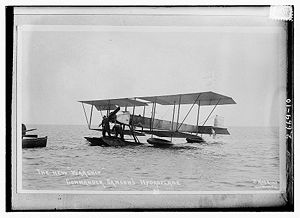Short S.41 Video - Picture

|
|
Short S.41
Short S.41

Role: Floatplane
National origin: United Kingdom
Manufacturer: Short Brothers
First flight: 2 April 1912
Introduced: 1912
Primary user: Royal Naval Air Service
Number built: 3 (S.41, S.51 and S.52)
Developed from: Short S.36
The Short S.41 was a British single-engined biplane built for the Royal Naval Air Service in 1912. Capable of being operated either on wheels or floats, it was successful enough for a further two similar aircraft to be built, with the type remaining in use until the early years of the First World War.
Development and design
In 1912, the Short S.36 biplane, built for the pioneer aviator Frank Maclean, was loaned to the Royal Naval Air Service (RNAS) for use at its Naval Flying School. Impressed by the S.36, the RNAS ordered two similar tractor biplanes capable of operating on either wheeld or floats, the smaller Short S.45, like the S.36, powered by a 70 hp (52 kW) Gnome, and the larger Short S.41 powered by a 10-cylinder, two row 100 hp (75 kW) Gnome rotary engine.
The S.41 was a two bay tractor biplane with a slim rectangular section fuselage mounted between the wings. It was first flown by Charles Rumney Samson on 2 April 1912 with its wheeled undercarriage, and was soon fitted with its float undercarriage, which consisted of two main pontoons under the fuselage and smaller floats at the wingtips and tail, and delivered to the Navy.
The folding wing mechanisms for ship-borne aircraft, developed and patented by Short Brothers, were first implemented and tested on the S.41 in November 1913. The wings were hinged so that they folded back horizontally alongside the fuselage, reducing the storage space required for stowage aboard ship.
Operational history
The S.41 was flown successfully at the Fleet Review at Weymouth on 8 May, being based on the Battleship HMS Hibernia. It was also used by Samson to carry out survey flights of potential sites for seaplane stations, which lead to the establishment of the seaplane station at Felixstowe, and for early trials with use of radio from aircraft.
The success of the S.41 (which was eventually given the serial number 10) was such that two similar aircraft, constructor's numbers S.51 and S.52 and also powered by the two-row Gnome were ordered by the RNAS, with serial numbers 20 and 21 which were flown in April 1913. Like 10, they were used for trials of airborne radio, as well as carrying out tests of beaching gear. They remained in use at the start of the First World War, where despite the unreliability of the two-row Gnome, they were used for anti-submarine patrols early in the war, 20 continuing in use from the seaplane station at Great Yarmouth until July 1915.
Operators
United Kingdom
Royal Naval Air Service
Specifications (S.41 seaplane)
Data from Shorts Aircraft since 1900
General characteristics
Crew: 2
Length: 39 ft (12 m)
Wingspan: 50 ft (15 m)
Height: 11 ft 9 in (3.58 m)
Wing area: 450 sq ft (42 m)
Empty weight: 1,100 lb (499 kg)
Gross weight: 1,600 lb (726 kg)
Powerplant: 1 x— Gnome 10-cylinder, two-row rotary engine, 100 hp (75 kW)
Performance
Maximum speed: 60 mph (97 km/h; 52 kn)
Endurance: 5 hrs
Barnes, C.H. Shorts Aircraft since 1900. London:Putnam, 1967.
Bruce, J.M. "The Short Seaplanes:Historical Military Aircraft No. 14 Part I". Flight, 14 December 1956. pp. 921-926.
Bruce, J.M. British Aeroplanes 1914-18. London:Putnam, 1957.
Short S.41 Pictures
Living Warbirds: The best warbirds DVD series.
Source: WikiPedia